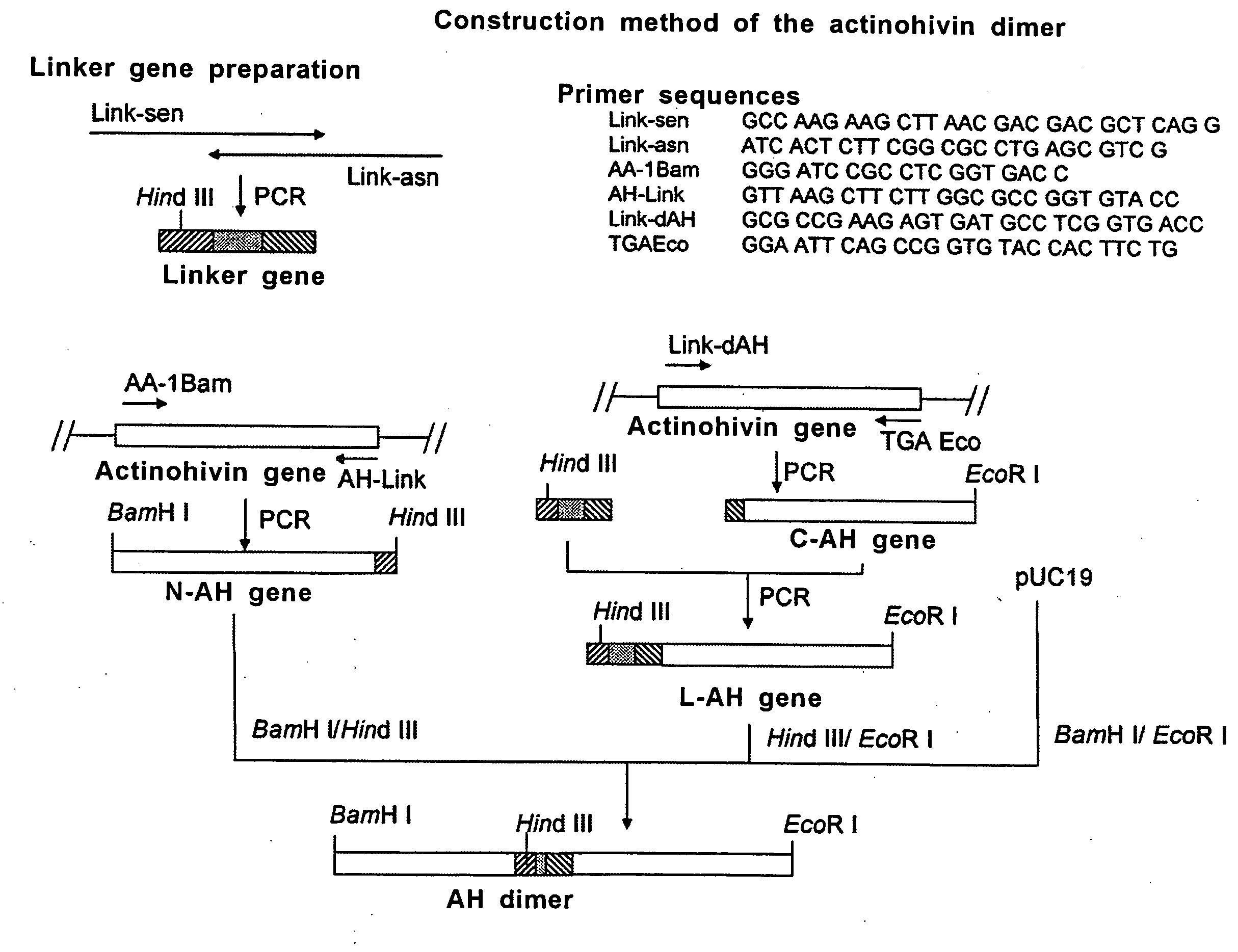Anti-Hiv Drug, Polypeptide Constituting the Same, Gene Encoding the Polypeptide and Method of Producing the Anti-Hiv Drug
a technology of anti-hiv drug and polypeptide, which is applied in the field of antiviral agents, can solve the problems of low stability, severe side effects, and decreased sensitivities, and achieve the effect of preventing infection and being readily produced
- Summary
- Abstract
- Description
- Claims
- Application Information
AI Technical Summary
Benefits of technology
Problems solved by technology
Method used
Image
Examples
example 1
(1) Construction of Gene Coding for Actinohivin Dimer
[0042]The gene (SEQ ID No. 4) coding for the actinohivin dimer as defined in SEQ ID No. 3 was constructed according to the protocol as shown in FIG. 1.
[0043]Firstly, a linker gene coding for 13 amino acid residues for ligating two actinohivin genes was prepared as follows.
[0044]Synthetic oligonucleotide Link-sen (SEQ ID No. 5) and Link-asn (SEQ ID No. 6) were annealed at the homologous sequence sites of 11 bases added to the 3′- and 5′-termini, respectively, of the both primers to form a primer dimer. The resultant was subjected to PCR under the conditions of 30 seconds at 94° C., 60 seconds at 60° C., and 1 minute at 72° C. (30 cycles).
[0045]Next, an actinohivin gene corresponding to the N-terminal portion of actinohivin dimer (N-AH gene) was prepared by PCR under the conditions of 30 seconds at 94° C., 30 seconds at 60° C., and 1 minute at 72° C. (30 cycles) using two synthetic oligonucleotide primers AA-1Bam (SEQ ID No. 7) and ...
comparable example 1
(1) Construction of Actinohivin (Monomer) Expression Plasmid
[0053]Actinohivin gene as defined in SEQ ID No. 1 was amplified by performing PCR using plasmid 2A3K as the template and AA-1 LIC (SEQ ID No. 11) and TGA 114 LIC (SEQ IDNo. 12) as described above under the conditions of 30 seconds at 94° C., 30 seconds at 60° C., and 1 minute at 72° C. (30 cycles). The resulting DNA fragment was subjected to T4DNA polymerase reaction in the presence of dGTP and then ligated to E. coli expression vector pET30 Xa / LIC to constract the actinohivin (monomer) expression plasmid pET30:AH.
(2) Expression of Actinohivin (Monomer) by E. coli
[0054]Actinohivin (monomer) was expressed in E. coli BL21 (DE3)plysS transformed by a procedure similar to that in Example 1, (3), except for that the actinohivin (monomer) expression plasmid pET30:AH was used in place of the actinohivin dimer expression plasmid pET30:dAH.
example 2
[0055]According to the procedures described below, the actinohivin fusion protein was prepared and purified, and tested for its anti-HIV effects.
[0056](1) Preparation of E. coli Extract
[0057]According as Example 1, E. coli cells containing the actinohivin dimer with a His tag expressed in the cells were suspended in 10 ml of a binding buffer (5 mM imidazole, 0.5 M NaCl, 20 mM Tris-HCl (pH 7.9)). The cells were disrupted by sonication of 1 minute with 30 seconds interval (total 5 minutes). The resulting E. coli extract was centrifuged at 8,370×g for 10 minutes at 4° C. and the supernatant and pellet were separated. The pellet obtained was dissolved in the binding buffer containing 6 M guanidine (hereinafter, the binding buffer DN), and the solution was centrifuged at 8,370×g for 10 minutes at 4° C. to remove the pellet.
[0058](2) Affinity Chromatography with Metal Chelate Sepharose 4B
[0059]Five ml of metal chelate Sepharose 4B was poured in a 15 ml plastic tube, to which 10 ml of mill...
PUM
| Property | Measurement | Unit |
|---|---|---|
| concentrations | aaaaa | aaaaa |
| concentrations | aaaaa | aaaaa |
| pH | aaaaa | aaaaa |
Abstract
Description
Claims
Application Information
 Login to View More
Login to View More - R&D
- Intellectual Property
- Life Sciences
- Materials
- Tech Scout
- Unparalleled Data Quality
- Higher Quality Content
- 60% Fewer Hallucinations
Browse by: Latest US Patents, China's latest patents, Technical Efficacy Thesaurus, Application Domain, Technology Topic, Popular Technical Reports.
© 2025 PatSnap. All rights reserved.Legal|Privacy policy|Modern Slavery Act Transparency Statement|Sitemap|About US| Contact US: help@patsnap.com


